Taking the Waters: Strange Treatments at a Government-Run Spa
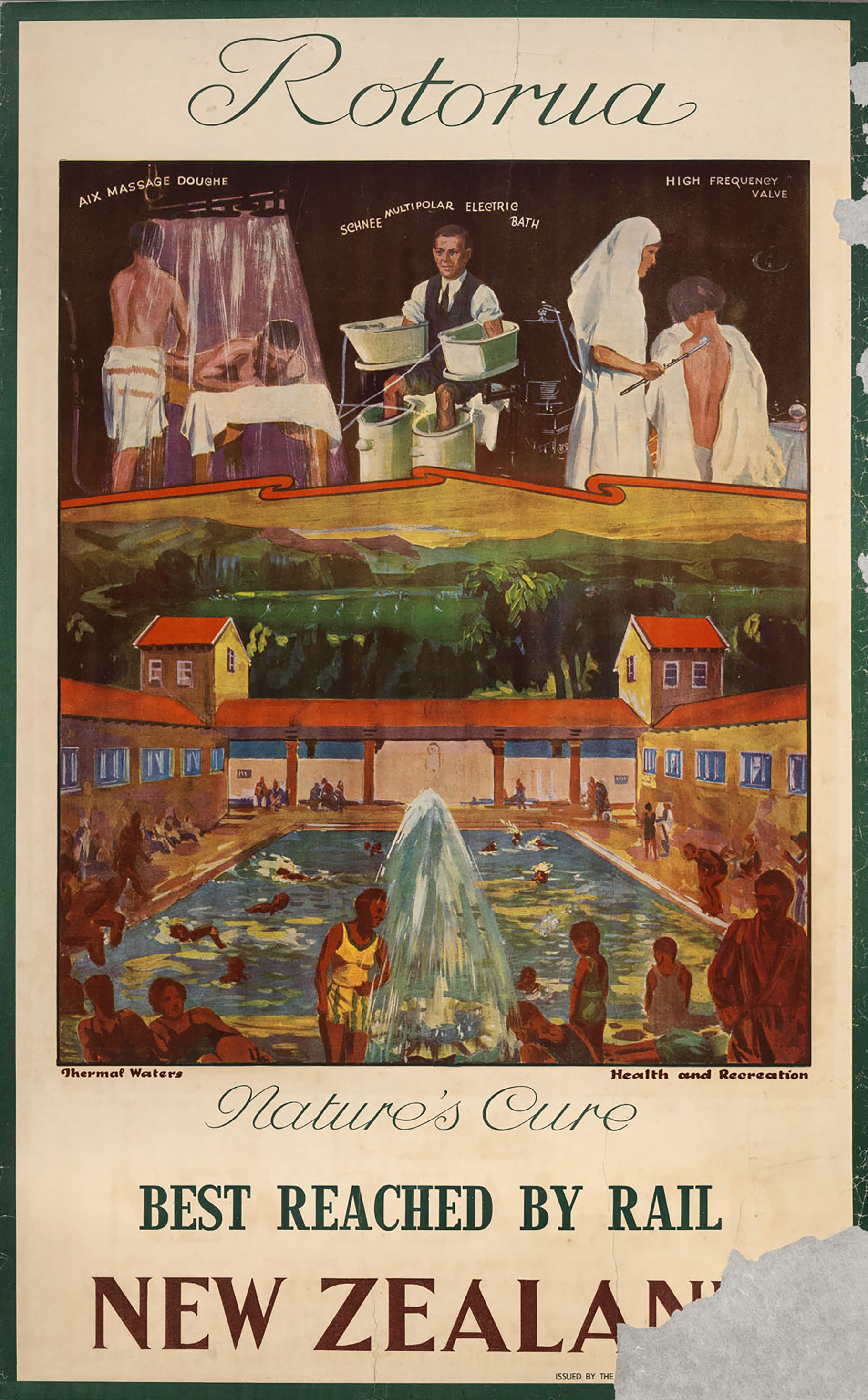
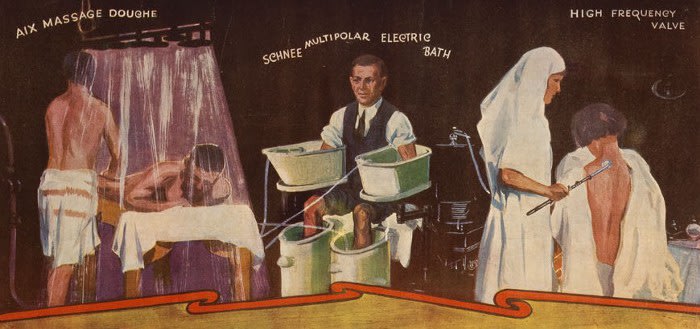
The finest and strangest treatments available at the Rotorua Bath House in the 1930s. Detail from ART-2019–20.12 Walsh Memorial Library, The Museum of Transport and Technology (MOTAT)
The incredible geological activity in and around Rotorua have made it a literal tourist hotspot. Such is its unique addition to the New Zealand experience that in 1907, the recently-formed Department of Tourism and Health Resorts (the first such department in the world, by the way) ran the entire town. Even in 1922, when the Department relinquished control of the town and Rotorua became a borough, the department retained control of the Bath House. It was in this era of government-run resorts that the rail poster for Rotorua was produced.
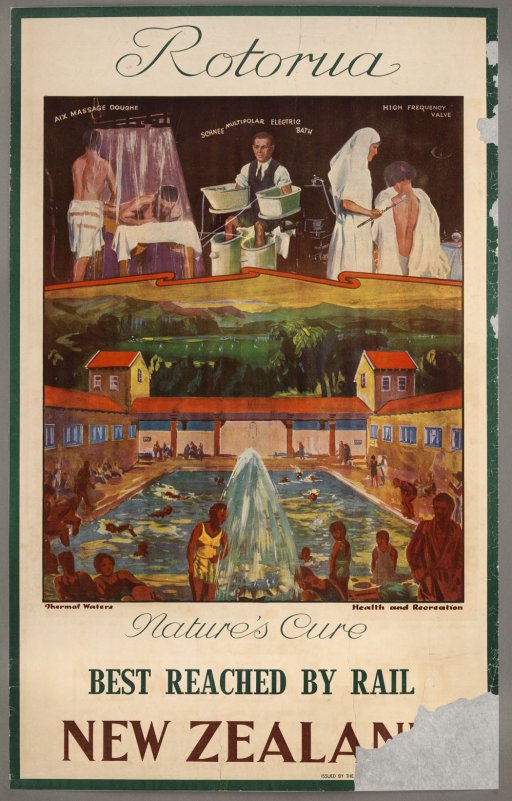
ART-2019–20.12 Walsh Memorial Library, The Museum of Transport and Technology (MOTAT)
This poster which was created by another government department, the Railways Publicity Branch, shows the busy Bath House, with a view to the serene lake beyond. Across the top of the poster, separated by an architectural koru design, are teasers of the cutting-edge treatments on offer at the resort. (All three illustrations used official publicity photos for reference. The originals are archived at the National Library and feature in a two-page spread in the February 1933 issue of New Zealand Railways Magazine, which you can read at MOTAT’s Walsh Memorial Library.) These exotic, high-tech sounding treatments — Aix Massage Douche, Schnee Multipolar Electric Bath, and the High Frequency Valve — have little or no connection to the natural hot pools of Rotorua. So what were these treatments? What did they do? Did they actually do anything at all?
The Aix Massage Douche originated in the resort town of Aix-les-Bains in the French Alps. The masseuses of Aix-les-Bains have used this technique since the early 1800s. Local histories, however, trace its origins to an ancient Egyptian practice brought back to France by Napoleon Bonaparte. As Aix-les-Bains is itself a thermal spa town, its signature massage was a perfect fit for Rotorua.
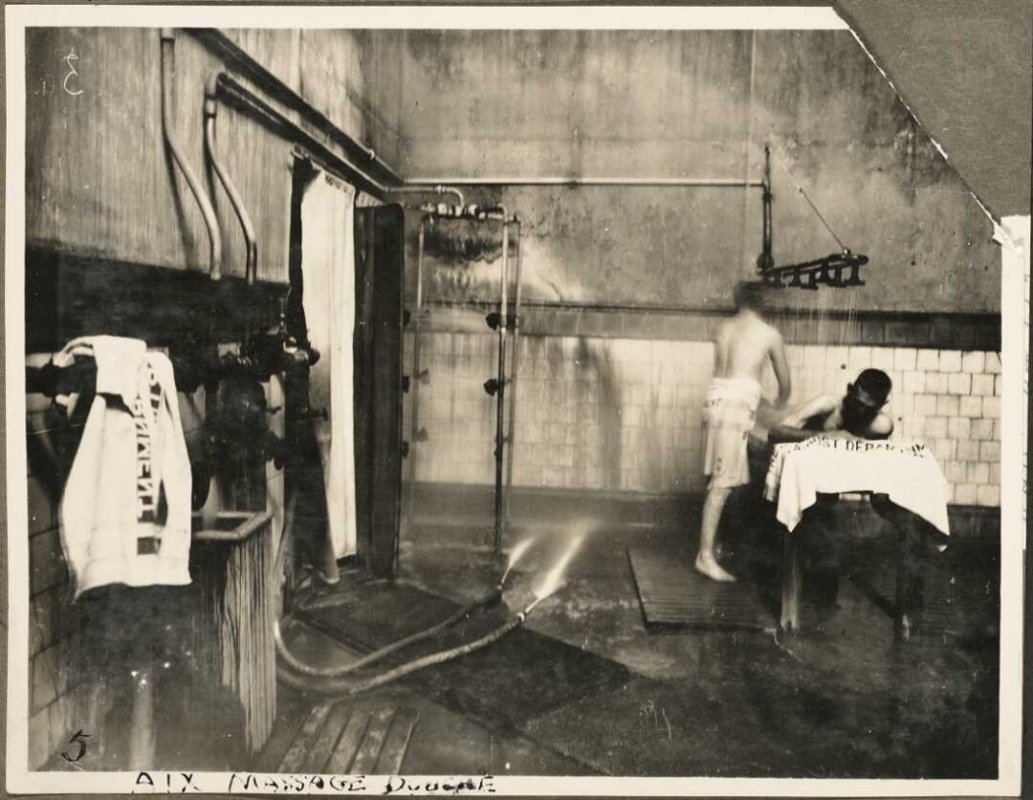
What a serene, relaxing environment for a massage! Aix massage douche, Sanatorium, Rotorua, New Zealand. Ref: PA1-f-051–26–3. Alexander Turnbull Library, Wellington, New Zealand. /records/22830728
The Aix Massage Douche (that’s ‘douche’ in the original sense: a device producing a stream of water) channels heated water through a series of adjustable overhead nozzles. The client is therefore massaged by both the masseuse and by the pressurised, thermally heated water. Earlier versions used in France had a single nozzle, attached to a hose, moved about the body by the masseuse as they worked. Modern versions of the Aix method are still used in Rotorua’s spas today, though I cannot guarantee they are still administered by muscular blokes in towels.
The other two treatments on the poster have their origins in the mid-1700s. With the invention of the Leyden Jar, humans could for the first time generate electricity — though nobody quite knew what to use it for. German physician Johann Gottlob Krüger summed up the prevailing theory of the time:
All things must have a usefulness; that is certain. Since electricity must have a usefulness, and we have seen that it cannot be looked for either in theology or in jurisprudence, there is obviously nothing left but medicine.
Soon the market was flooded by quack treatments and pseudo-scientific machines to cure any and every ailment: from galvanic amulets that ward off disease to electrified beds for increased fertility. While the more outrageous of these had been abandoned by the twentieth century, there were still some electric shock treatments on offer in the nation’s government-run resorts, giving new meaning to the phrase ‘politically charged.’
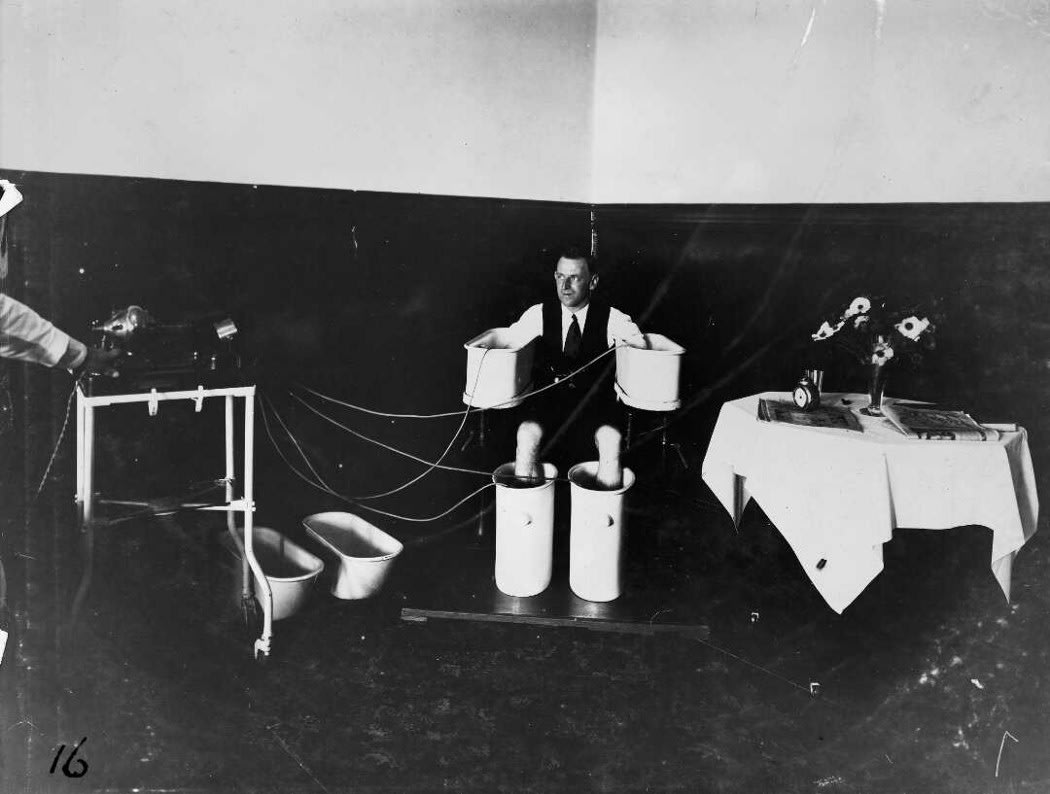
Nothing says ‘day at the spa’ like a three piece suit. Schnee multipolar electric bath, Sanatorium, Rotorua. Ref: PA1-f-051–29–4. Alexander Turnbull Library, Wellington, New Zealand. /records/22759354
The Schnee Multipolar Bath claimed to relieve muscle and joint pain and was used as a treatment for arthritis and rheumatism. It consisted of four porcelain basins — one for each limb. The basins were filled with water and connected to an electrical generator operated by a nurse. The well-insulated porcelain meant there was no risk of electrocution through grounding. With four small tubs there was no need to undress — just roll up your sleeves and trousers and away you go. In this way, it was seen as a quicker alternative to a hot pool, which provided much the same relief. It would appear, then, that practitioners of the Schnee Multipolar Bath completely missed the point of luxuriating in a hot pool.
Like so many quack medicines, the High Frequency Valve (commonly marketed as The Violet Ray) claims to cure everything. The apparatus itself looks like a prototype lightsaber with a handle connected by a cable to a control box. From the other end of the handle a glass tube emits an eerie light. This glass fitting is a vacuum tube, which allows a low-current, high-frequency arc of electricity to pass through it. Different shaped glass tubes can be fitted to the handle, ostensibly to treat different ailments. A fitting ending in a point focuses electricity on a specific point; a rake-shaped fitting can be dragged down an aching back; a wide, lobe-shaped tube is used to massage the temples. There is no evidence to suggest any of these fittings are more effective than a regular massage. Despite this, there are still companies selling home Violet Ray kits today.
Rotorua City Council took over the Bath House in 1963 and moved its treatment facilities to the local hospital three years later. Still a popular resort destination, Rotorua has a number of thermally-heated spas offering the kind of experiences advertised in this rail poster. There is more of a focus on relaxation these days, and less on electrocution.
References:
Electrotherapy Museum, Violet Ray Misconceptions. Date Accessed: 22 July 2020, URL: http://electrotherapymuseum.com/Articles/VioletRayMisconceptions.htm
Forestier, Henri, Aix-les-Bains thermal treatment, London : Churchill, 1908.
Date Accessed: 22 July 2020, URL: https://wellcomecollection.org/works/wyx2bb6g
McKinlay, A.D, In the Heart of Wonderland: Places of Scenic Interest and Charm near Rotorua, New Zealand Railways Magazine, 1933, vol. 7, issue 8, p. 31–40
Rotorua Museum, The Tourism Story. Date Accessed: 22 July 2020, URL:
https://www.rotoruamuseum.co.nz/visit-us/taking-the-cure/tourism-and-the-rotorua-story/
Wellcome Collection, Electric marvels in the age of enlightenment. Date Accessed: 22 July 2020, URL: https://wellcomecollection.org/articles/XN0zbhAAAPDHoFl
Thanks to Megan Hutching.
CITE THIS ARTICLE:
Dixon, Todd. Taking the Waters: Strange Treatments at a Government-Run Spa MOTAT Museum of Transport and Technology. First published: 04 August 2020. URL www.motat.nz/collections-and-stories/stories/taking-the-waters-strange-treatments-at-a-government-run-spa